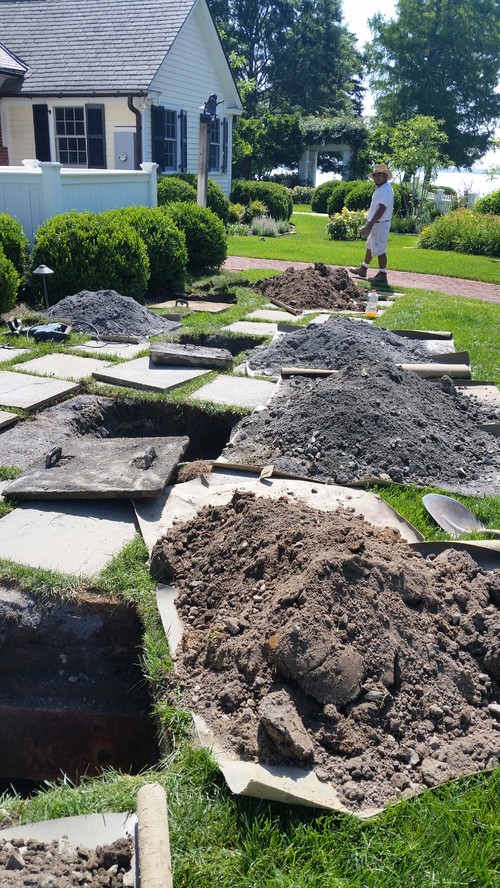The most homes are connected to a public sewage treatment system. However, million families live in rural and sparsely developed suburban areas not served with a public system. In this case, people install their own, private sewage treatment plants.
They are called septic tanks.

Photo by Livingston Septic Service – More exterior home ideas
What is Home Septic System?
A septic system has two major components: a septic tank and a drain field.
1. Septic Tank
A septic tank is simply a big concrete or steel tank that is buried in the yard. A septic system processes and neutralizes liquid and solid waste that exits your home from stools, sinks and other plumbing fixtures.
The tank is designed to retain waste water and allow heavy solids to settle to the bottom. The tank might hold 1,000 gallons (4,000 liters) of water. Waste water flows into the tank at one end and leaves the tank at the other. The settled heavy solids are partially decomposed by bacteria to form sludge. Grease and light particles float, forming a layer of scum on top of the waste water. Baffles are installed at the inlet and outlet of the tank to help prevent scum and solids from escaping.
The tank must be large enough, and the rate of flow small enough, to ensure sufficient “residence time” of wastewater in the tank. The exit baffle arrangement holds back sludge and scum while allowing a partially digested wastewater to flow out of the tank.
Newer septic tanks can have a partial concrete dividing wall in the center, thus making two compartments. This helps ensure the sludge does not get forced out of the baffle into the drain field.
2. Drain field (Trench)
A solid pipe leads from the septic tank to a distribution box where the waste water is channeled into one or more perforated pipes set in trenches of gravel.
The distribution box (header pipe) may be attached directly to the septic tank or connected to it by a short length of pipe.
The drain field is positioned so that gravity allows liquid waste to flow and become distributed into the area. Dissolved wastes and bacteria in the water are trapped or adsorbed to soil particles or decomposed by microorganisms. This process removes disease-causing organisms, organic matter, and most nutrients (except nitrogen and some salts).
Soil beneath the gravel-filled trenches or bed must be permeable so that wastewater and air can move through it and come in contact with each other. Good aeration is necessary to ensure that the proper chemical and microbiological processes will be occurring in the soil to cleanse the percolating wastewater of contaminants. A well-aerated soil also ensures slow travel and good contact between wastewater and soil.
The purified wastewater then either moves to the ground water or evaporates from the soil. Trench systems are the most common type of system used in new home construction.
However, there are alternatives to the common drain field such as: Seepage Pit (Dry Well) or Seepage Pit (Dry Well). These systems are used in areas where the site is not suitable for traditional septic systems.
Septic System Problems:
The septic system of your home requires proper care and maintenance.
Some septic system problems can be caused by a drain field or system that is too small or too large.
Many others problems are caused because of a garbage disposal unit or feminine hygiene products which are flushed down the toilet.
Small homes can have different septic system problems than large homes, and the home size and number of occupants is an important consideration when your septic system is being designed and installed. If the septic tank is too large the septic system cannot function optimally. If it is low amounts of waste your septic system may not be able to create the bacteria and heat needed to operate efficiently.
Some large homes may require two septic systems to avoid any septic system problems, with tanks located on opposite sides of the home. Two septic tanks and systems can ensure that your septic system can handle the waste created on even the busiest day n your home.
Sub-Rough Plumbing and HVAC Installation Schedule (howtobuildahouseblog.com)
Symptoms of a Deficient Septic System:
a) Slow drains anywhere in your home.
b) Sewage backup which may have a bad odor
c) An area of your lawn that is wet or soggy, and which is located on or near the drain field
d) A foul odor on your property and sewage ponds on your property
e) Toilets which back up frequently or toilets which do not flush properly and dispose of all the waste the first time
Ways to Prevent Septic System Problems:
a) Never flush anything except for waste and toilet paper down the toilet.
b) Try to use water evenly and sparingly, so that your system is not overwhelmed. Try to do laundry each day instead of having a single day for all the laundry.
c) Don’t use garbage disposal; food does not degrade the same way that human wastes do.
d) Don’t pour oil or grease into any drains.
e) Make sure you have your tank pumped every three to five years.
f) Don’t plant trees near your septic system; tree roots can rupture pipes, cause blockages, and create havoc on a septic system.
g) Don’t pour chemicals in your drain. They may interfere with the way that your system works, and will cause damage to the soil.
h) Do not allow vehicular traffic over the drain field, which can compact the soil and possibly break drain lines;
i) Keep a healthy grass cover over the system to prevent exposure of the soil and possible erosion around the drain lines.
When You’re Buying Land:
Always make your purchase of an undeveloped piece of land without sewer connections contingent on obtaining a permit to install a septic system. There are some soils that are not suitable for any type of system. Approval of the site must take into consideration numerous other factors, including proximity of the site to surface waters and to drinking water supply wells.
If you are purchasing a house already on a septic system, ask for a copy of the original septic permit, since it should show you the location of the tank and drain field.
Conclusion:
The homeowner should be concerned not only with the hydraulic functioning of the system, but also with its environmental functioning. Have the tank inspected regularly, and pumped when necessary. Your attention will help keep your system working properly and protect the environment at the same time.
